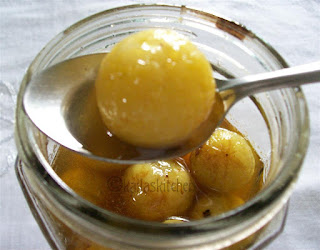I was watching a travel show in a Malayalam channel. The hostess takes the viewers through a culinary journey. In one episode, the recipe was Ashoka halwa and the cooking episode is shot at a normal house and cooked by the lady of that house. That aunty mentioned it was famous in Thiruvaiyar/Tanjore area. And its also called as Thiruvaiyar Halwa similar to the halwa of Tirunelveli. Ashoka halwa is made using moong dal and its lot simpler to make. Watching the episode, I was tempted to make it immediately and made a mental note of the ingredients and measurements. I have made it long time back and the recipe was missing in my book. The aunty who made it was mostly eyeballing the measurements. Considering her age, she must be quite experienced in making it and she doesn't need cups and spoons as we swear by. The hostess tried to get across the measurements partially in weight and cups.
This is how I went about doing it.
Moon dal - 1/2 cup
Sugar - 1 1/2 cups
Maida - 1/4 cup
Wheat flour -1/4 cup
Ghee- 1/2 cup
Caradamom powder - 1 tspn
Red food color - a pinch
Cashew nuts - 10 nos
Method
Dry roast the moong dal till light brown. I usually roast the dal before storing them. Wash and pressure cook in 1 1/2 cups of water for 2 whistles. Mash the cooked dal well. There will not be excess water in the cooked dal.
Heat a kadai with a tablespoon of ghee. Roast cashewnuts to golden brown. Drain them and roast both maida and wheat flour separately for few minutes. Keep them aside. In the same kadai, mix cooked and mashed dal and sugar. Heat the mixture. When it starts bubbling, slowly stir in both the flours and a pinch of red color. Add ghee at intervals. When the whole mixture comes together and starts leaving the sides, remove from fire. Add roasted cashewnuts and cardamom and give a good stir.
This halwa is not very sweet and with comparitively less amount of ghee used, its not dripping with ghee kind.




















